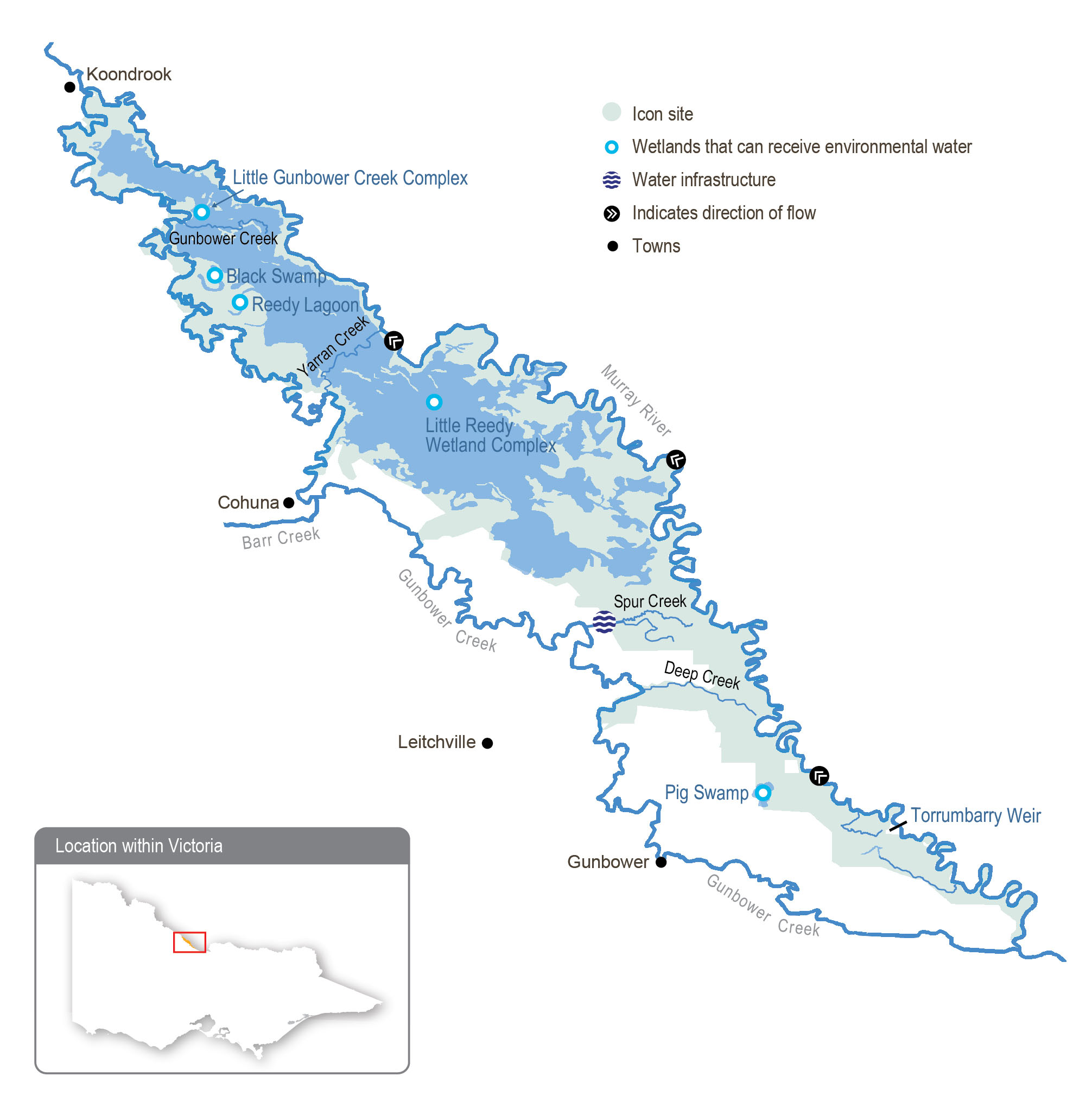The Barapa Barapa are the Traditional Owners in the middle and lower area of Gunbower Forest, and the Yorta Yorta are the Traditional Owners in the upper Gunbower Forest.
The North Central CMA seeks engagement and input from both Traditional Owner groups when undertaking annual environmental water planning and throughout the year as part of the Living Murray Indigenous Partnerships Program.
Yorta Yorta custodians and Barapa Barapa custodians have clearly expressed their aspirations for an active role in the management of land and water to fulfill custodianship obligations and contribute to improvements in the health of Country.
Barapa Barapa custodians and North Central CMA staff spent two days in Gunbower Forest in early 2023 to reflect on the condition of the forest and creek, share knowledge, and discuss environmental watering plans for 2023-24 and other opportunities to improve the health of the forest and creek. Barapa Barapa custodians released several Murray cod and golden perch that were salvaged during the low-oxygen blackwater event in 2022 back into Gunbower Creek. Concerns were raised about the potential for future low-oxygen blackwater events.
Increasing the involvement of Traditional Owners in environmental water management and progressing opportunities towards self-determination in the environmental watering program is a core commitment of the VEWH and its agency partners. This is reinforced by a range of legislation and policy commitments, including the Water Act 1989, the Victorian Aboriginal Affairs Framework, the 2016 Water for Victoria, the Water is Life: Traditional Owner Access to Water Roadmap 2022, and in some cases, agreements under the Traditional Owner Settlement Act 2010.
Where Traditional Owners are more deeply involved in the planning and/or delivery of environmental flows for a particular site, their contribution is acknowledged in Table 5.2.7 with an icon. The use of this icon is not intended to indicate that these activities are meeting all the needs of Traditional Owners, but is incorporated in the spirit of valuing that contribution.
 | Watering planned and/or delivered in partnership with Traditional Owners to support cultural values and uses |
Barapa Barapa custodians have been working in partnership with the North Central CMA to deliver the Water for Country project in Gunbower Forest since 2015. The Water for Country project builds on the work of the previous Barapa Barapa Cultural Heritage Mapping of Lower Gunbower Forest project, delivered in 2013-14, to map a catalogue of cultural heritage assets in the forest. The Water for Country project aims to investigate how Traditional Owners’ cultural and spiritual values can be better represented in water management. In 2018, the Water for Country group expanded to also include Wamba Wemba custodians; the group continues to focus on Gunbower Forest.
Table 5.2.5 identifies opportunities to support cultural values with water for the environment. These have been informed by the Barapa Barapa Watering Objectives Framework (see Table 5.2.6) and North Central CMA engagement with Barapa Barapa custodians in early 2023.
Table 5.2.5 Cultural values and uses at Gunbower Forest as identified by the Barapa Barapa Wamba Wemba Water for Country project
| Value/use | How the value/use will be considered by environmental flows in 2023-24 |
|---|
|
Cultural plants, cultural practices
| - Water in wetlands and on the floodplain from deliveries of water for the environment and natural flooding supports culturally important plants throughout Gunbower Forest and allows the continuation of cultural practices, including harvesting of food, medicine, and weaving plants.
- The watering actions via the Hipwell channel in 2023-24 will support cultural plants that Barapa Barapa custodians value and provide opportunities for cultural practices to continue.
- The abundance of cultural resources available is linked to the scale of watering that can be achieved. Floodplain watering via the Hipwell channel provides a greater amount of resources and enables resourceful harvests with less travel and effort.
- Barapa Barapa custodians recognise the value of resources that occur on the drawdown after the inundation of the forest floodplain, providing food for animals and cultural plants (such as old man weed). This can be supported by allowing wetlands to draw down naturally prior to the floodplain watering in winter 2023 and through summer and autumn 2024.
- Having a diversity of habitat and vegetation responses is a priority for Barapa Barapa custodians. They consider it important to have a range of water depths, which creates a more diverse vegetation response and results in a variety of resources becoming available over a longer period.
|
|
Healthy Country
| - Providing drought refugia and maintaining areas with healthy habitat is a high priority for Barapa Barapa custodians.
- Deliveries of water for the environment will ensure water is present on the floodplain and in high-priority wetlands regardless of whether there is unregulated flooding. This will provide refuge habitat for forest fauna, and the delivery of water across most of the Gunbower Forest wetlands will ensure that high-quality habitat is available.
|
|
Cultural heritage
| - Barapa Barapa custodians value having water in natural creeks and billabongs off main wetlands, which can contain cultural heritage sites, including earth mounds and a large canoe tree on the edge of a large flood runner.
- Delivering water to the floodplain supports this with water flowing through natural creeks and flood runners on the floodplain. Deliveries of water for the environment result in lower levels than natural flooding, which can ensure that earth mounds or other cultural heritage are not overtopped and harmed.
- Barapa Barapa custodians have noted that areas of black box and river red gum have cultural heritage values, but the changed watering regime since regulation and climate change is causing the encroachment of black box into areas previously dominated by river red gum. Barapa Barapa custodians expressed the desire to preserve the tree community that was historically present, which is supported by the delivery of water to the floodplain. The lower landscape regulators can target small areas of river red gum, and the Hipwell channel watering planned in 2023-24 will inundate large areas of river red gum and potentially suppress black box encroachment within the flood footprint.
|
|
Cultural practices
| - Barapa Barapa custodians have aspirations to reintroduce traditional fish traps into natural creeks within Gunbower Forest. The flood runners around the Little Gunbower Creek complex have been identified as potential trial sites, and opportunities may be provided to pursue this in 2023-24.
- Traditional Owners have indicated that a smoking ceremony should be a regular activity each year when water is delivered, as it is something that their ancestors would have done when the floodwaters arrived and would represent a restoration of an important cultural practice. The timing of deliveries of water for the environment will be communicated to Traditional Owners so cultural opportunities can be realized.
|
|
Cultural resources
| - Barapa Barapa custodians have expressed that the ongoing survival of fish populations is important, as the fish are a food resource. In 2023, Barapa Barapa custodians are placing a high priority on protecting native fish populations in Gunbower Creek and avoiding any further fish deaths due to low-oxygen blackwater.
- Native wetland fish populations persisting in the Gunbower Forest wetlands following the 2022 floods will be supported by the planned floodplain watering, ensuring a resident fish population persists across multiple years. Watering the wetlands will also provide habitat for freshwater mussels in the wetlands.
|
The Barapa Barapa Wamba Wemba Water for Country project has led to the creation of the Barapa Barapa Cultural Watering Objectives Framework, which is a guiding document to ensure cultural priorities and outcomes are considered and incorporated in the planning for and management of water for the environment. The framework considers cultural objectives matched with hydrological considerations, indicators and measures for monitoring success, which Table 5.2.6 shows. These objectives are considered in conjunction with the environmental objectives and expected effects of the potential watering actions shown in Table 5.2.7.
Applying the framework during seasonal watering proposal engagement with the Barapa Barapa Wamba Wemba Water for Country project members ensures that planned environmental flows incorporate Barapa Barapa custodians’ cultural aspirations and that water managers are culturally informed when delivering water for the environment.
All the potential environmental watering actions in Table 5.2.7 provide the opportunity to support Barapa Barapa cultural values and objectives. Achieving them will depend on climatic conditions.
Table 5.2.6 Barapa Barapa cultural objectives for environmental flows in Gunbower Forest 2023-24 (from the Barapa Barapa Cultural Watering Objectives Framework)
| Cultural objective | Hydrological aim | Indicator | Measure | Watering action |
|---|
|
Promote and maintain healthy and abundant native fish communities in Gunbower Creek and Gunbower Forest
| - Presence of water in wetlands before spring to support native fish spawning events
| - Presence of native fish spawning
- Native fish populations show a range of ages
| - Fish surveys, larval sampling
| - Floodplain watering
- Wetland top-ups
- Yarran throughflow
|
- Presence of water in deep wetlands so that fish can survive for longer
| - Presence of native fish following watering event
| | |
|
Hydrological aim 3
| Presence of native fish following watering event | | |
Promote the natural flow of water | - Water flows via natural flow paths to culturally important sites
| - Presence of water at culturally significant sites (e.g., fishponds)
| - Photo points, site surveys
| |
- Presence of healthy-looking and healthy-smelling forest
| - Presence of healthy canopies and good ground cover on the forest floodplain
| | |
Promote and maintain healthy cultural plants and resources | - Presence of water on the floodplain, in small wetlands, and in depressions to provide resources across the forest, particularly in dry years
| - Presence of food and fibre resources distributed across the forest
| - Cultural harvests, plant surveys, seed collection
| |
- Presence of water in healthy wetlands
| - A diverse range of plants, animals, and insects living in harmony
| - Results of monitoring activities (e.g., macroinvertebrate surveys, flora and fauna surveys)
| |
Promote healthy waterbird populations | - Presence of water in wetlands that support waterbird breeding
| - Presence of waterbird breeding
| - Waterbird surveys, spring/summer surveys for eggs
| |
